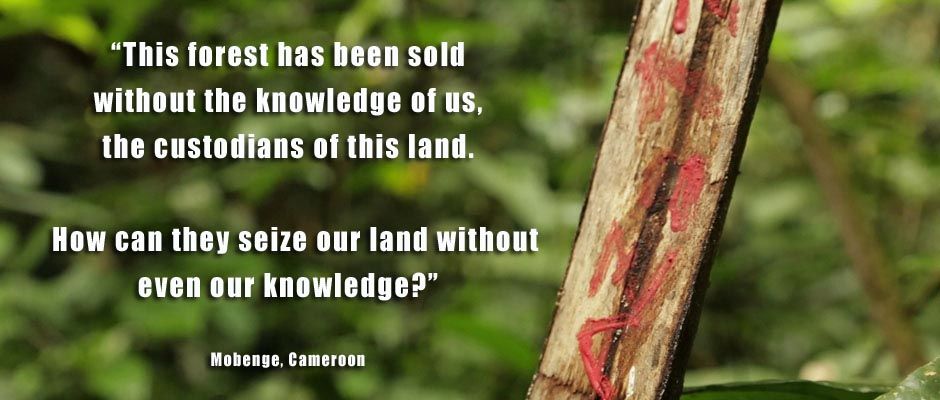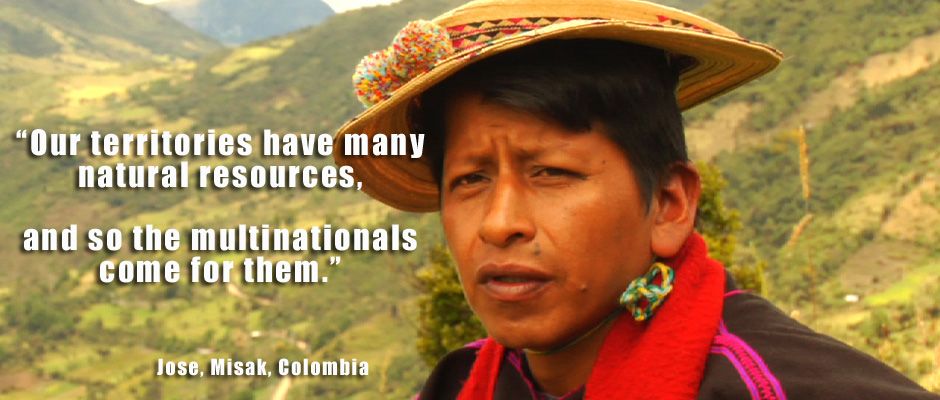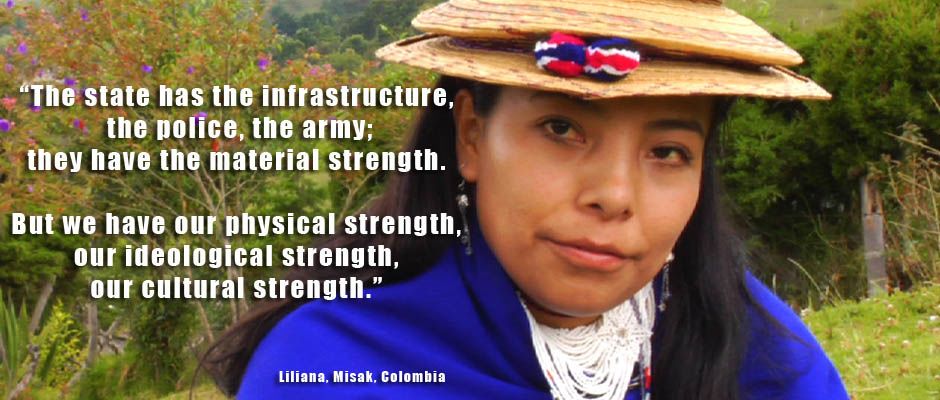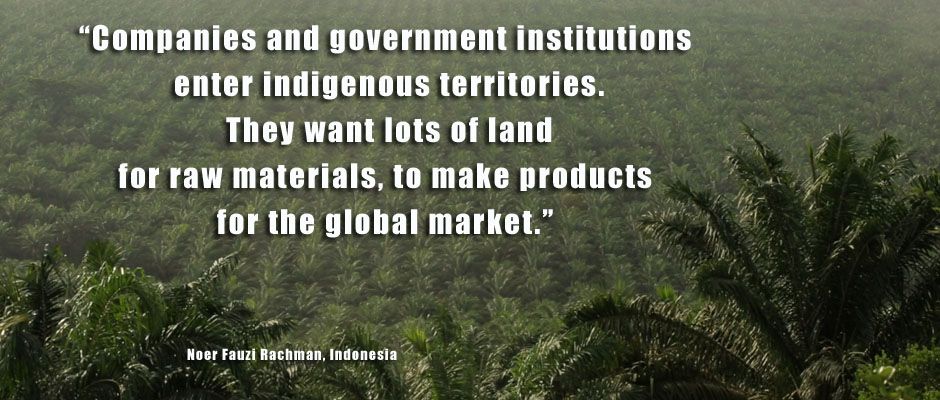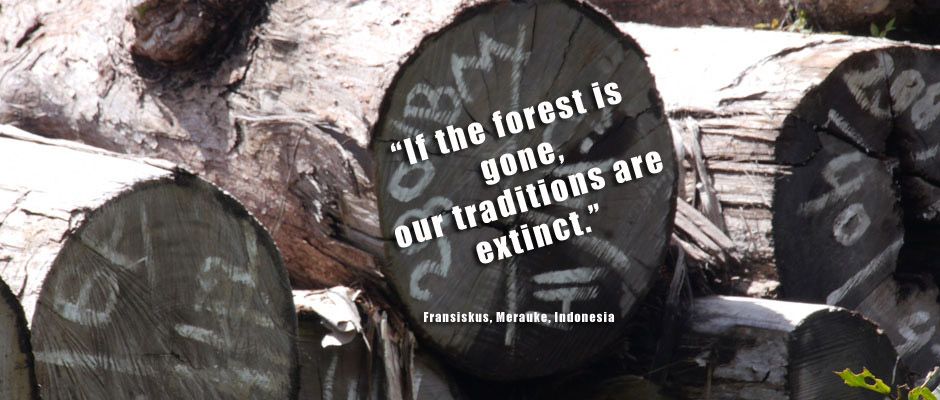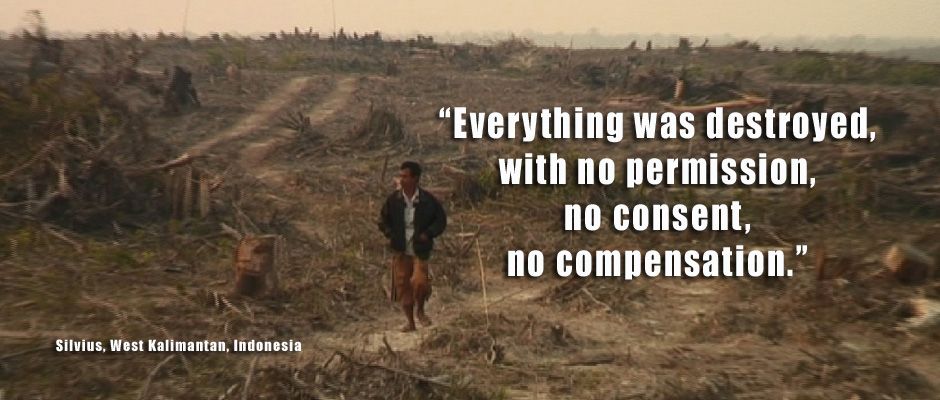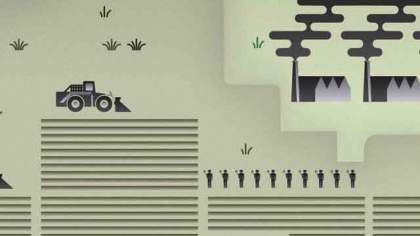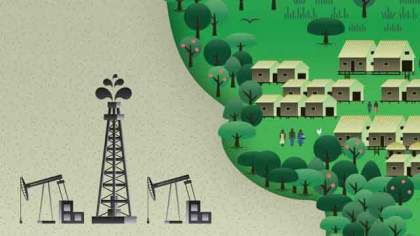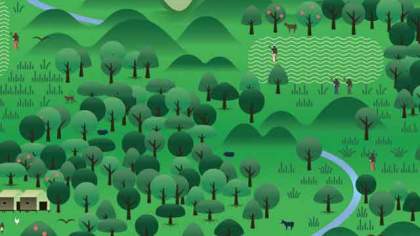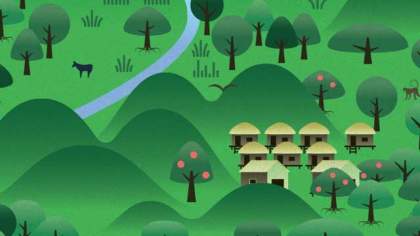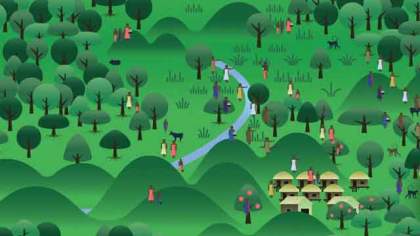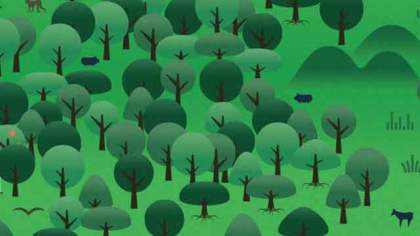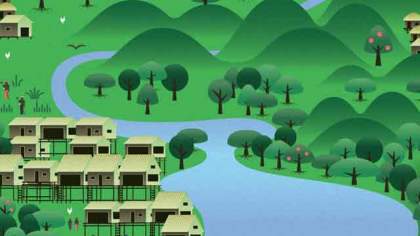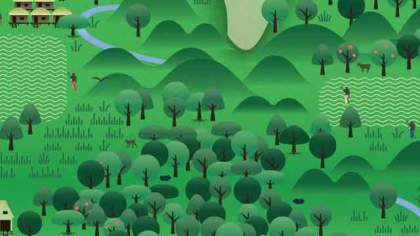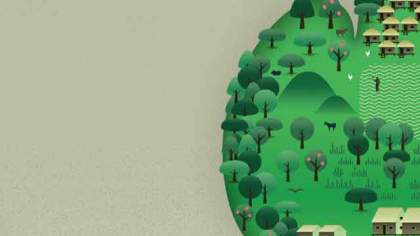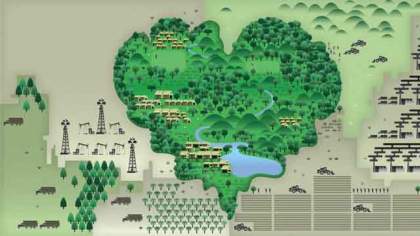-
What is 'Land Grabs' about?
Indigenous communities around the world are seeing their lands threatened by the extractive and agro-industries, by conservation schemes and by tourism developments. This video looks into the scale, drivers and impacts of the global rush for land. In this video we hear from indigenous peoples from Asia, Latin America and Africa who have first hand experience of the impacts of land grabs.
Length of video
14 minutes.
Why screen 'Land Grabs'?
This video should be screened in communities where plantations, mining or other large-scale developments are happening or could happen in the future. It can also be screened to government officials, in universities and to the general public to raise awareness of land grabbing.
Download Facilitators Guide here
Watch in French, Spanish, English, Indonesian, Swahili, Baka, Bagyeli, and Tok Pisin
Suggestions for Discussion Questions after community screenings
- What are the threats to your territory?
- What impacts do communities experience from losing their lands?
- What other large-scale developments are happening in your area?
- What are you currently doing to defend your land, what else could you do?
Suggestions for Follow-up Activities after community screenings
- Find out about the industries and companies that are operating in your area/province, as well as who are responsible for giving permits and concessions to operate.
- Visit a community that now lives in a plantation/next to a mining site to learn about the impacts they are experiencing.
Where are the communities in this video from?
Guarani, Enxet – Paraguay - Soy Plantations
Secoya – Ecuador - Oil Drilling
Misak – Colombia
Maasai – Tanzania - Conservation and Tourism
Nguti and Mundemba – Cameroon - Oil Palm Plantations
Malind - Merauke
Dayak - West Kalimantan
-
Documents and Downloads
Territories of Life - Facilitators Guide
This booklet is for community facilitators who are using the Territories of Life Video series. The booklet covers information about each video in the series as well as tips on hosting screenings, discussions and action planning sessions with communities.
Oil Dependency and the Peruvian Amazon: How Oil Companies Have Exploited the Rainforest of Loreto
For more than 40 years, oil activity has brought destruction to the ecosystems and the indigenous people of four river basins, all major tributaries to the Amazon, which gives life to the biggest rainforest on Earth. The operator responsible for this human and environmental disaster, Pluspetrol Norte S.A., has evaded any responsibility. The company’s contract expires on August 29, 2015, but now a new oil lot, 192, has been created and put up for sale. Three big oil companies have shown an interest, including Pluspetrol Norte S.A, but the indigenous people of the River Tigre have stated they will not permit this operator to stay one day longer on their territories. Read their testimonies and more about the impact of oil exploitation in this report (Chaikuni Institute, 2015).
Exploitation and empty promises: Wilmar’s Nigerian landgrab
This document uses first-person testimonies, satellite maps, and Wilmar’s own filings with the Roundtable on Sustainable Palm Oil to demonstrate that the company failed to gain the Free, Prior and Informed Consent of communities directly affected by its operations; failed to produce adequate Environmental and Social Impact Assessments; and failed to live up to promises of infrastructure development and benefit sharing, despite these promises being a primary incentive for local communities to allow the company to operate in Cross River State. (foei.org, 2015)
The Great Land Heist
Over recent years, a global land rush has resulted in a massive rise in the number of people in developing countries being evicted or denied access to their own land – sometimes in violent confrontation with the authorities – as big business moves in. . Offered little in the way of compensation or alternative livelihoods, millions are being forced into increased poverty, hunger and dispossession. (ActionAid, 2014)
The New Snake Oil? Violence, threats & false promises driving rapid palm oil expansion in Liberia
As Liberia emerges as a new frontier market for the world’s cheapest, most popular vegetable oil, The New Snake Oil details how state officials are said to be helping the palm oil company Golden Veroleum (GVL) harass communities into signing away their land and crush dissent. The report also documents the huge foreign investment, state-sanctioned violence, and regulatory black holes that are making this possible. Global Witness reveals how GVL (whose parent company is the Indonesian Golden Agri-Resources) accelerated its operations at the peak of Liberia’s 2014 Ebola outbreak. This report comes at a point when ten percent of Liberia has been designated for agricultural plantations, despite the lack of a legal framework to regulate how companies acquire contracts, operate and remain accountable for their activities (www.globalwitness.org, 2015).
West Papua Oil Palm Atlas
The West Papua Oil Palm Atlas portrays a frontier region's early encounters with a crop that has come to dominate the Sumatran and Bornean landscapes.
Communities as Counterparties
An analysis of almost 73,000 concessions in eight tropical forested countries, more than 93% of these developments were found to involve land inhabited by Indigenous Peoples and local communities. This report, prepared by The Munden Project, highlights the alarming amount of land that governments have handed over to the private sector for mining, logging, agriculture, oil and gas, including 40% of all land in Peru and 30% in Indonesia. (RRI 2014)
Planet palm oil
Expanding production of cheap palm oil comes at a high price. Destruction of rainforests, labour exploitation, and brutal land grabbing: these are just a few of the nasty consequences that come with today's oil palm plantations. With palm oil companies finding lands in Indonesia and Malaysia more difficult to acquire, attention is shifting to Africa. Over the past fifteen years, foreign companies have signed over 60 deals covering nearly 4 million hectares in central and western Africa for the development of oil palm plantations. The land grabs are already generating violent conflicts in several African countries. (GRAIN, 2014)
Other videos
Fever: Impacts (English)
Part 2: Impacts shows how large-scale industries such as plantations, coal mining and oil extraction impact on indigenous peoples livelihoods and rights as well as contributing to global climate change. (LifeMosaic, 2010)
Behind the Page - Part 1
Behind the Page (Di Balik Kertas) is a 2 part film about industrial timber plantations (HTI) in Indonesia. The film is designed to be used by local facilitators and communities whose lands are in or near existing HTI permit areas, or in areas where new permits for mills or HTI plantations will be allocated. The film is based on the voices of people from 8 communities in Papua, North Sumatra, Riau and Jambi, which have lost part or all of their ancestral land to HTI. How has this change impacted their community economies, their water, culture, food security and land rights? And how are they organising themselves to face these challenges? (LifeMosaic, 2012)
Progress or Problem? Oil Palm Plantation (English Subtitles)
Indonesia is the biggest producer of palm oil in the world. This film is based on the voices of indigenous peoples in Indonesia who have directly experienced the impacts of oil palm plantations on the land that they have lived and worked on for generations. The film is one-hour educational film made with 20 indigenous communities in Indonesia. It aims to help community members in oil palm plantations or plantation expansion areas to make informed decisions on the future uses of their ancestral lands. Part 1 focuses on the impacts of oil palm and contains an introduction, and chapters on local economics, farming systems, water, culture, land and conflict. (LifeMosaic, 2007)
Eyes on the Kampar Peninsula
The Kampar Peninsula is 700,000 hectares of peatland up to 15 metres deep, on the island of Sumatra, Indonesia. The peat contains more than 2 billion tonnes of carbon. 400,000 hectares of forest remain standing, 300,000 hectares have been converted to oil palm and pulp and paper plantations. All eyes are on the Kampar: loggers, carbon traders, and plantation companies including the giant RAPP pulpwood planter. But where does this leave the Akit and Melayu indigenous peoples who inhabit the peninsula? This film tells the human story behind one of the biggest carbon stores in the world. (LifeMosaic, 2009)
Related links
Dirty Money - financing of coal mining in Indoensia
An online, interactive documentary exploring how UK banks are financing coal mining in Indonesia. Combining photography, video, graphics and voiceover, you can navigate your own way through a range of material exploring the issue. The documentary includes a wide range of interview clips, including indigenous people whose homelands have been destroyed by coal mining, people in the mountains of Java running their own renewable energy projects, finance experts and campaigners. (World Development Movement, 2013)
Engage Media
An online video sharing site focused on social justice and environmental issues in the Asia-Pacific.
farmlandgrab.org
This website contains mainly news reports about the global rush to buy up or lease farmlands abroad as a strategy to secure basic food supplies or simply for profit. Its purpose is to serve as a resource for those monitoring or researching the issue, particularly social activists, non-government organisations and journalists.
Forest Peoples Programme
Forest Peoples Programme (FPP) was founded in 1990 in response to the forest crisis, and focuses on working to support the rights of forest dependant communities around the world. The website includes an overview of the NGO's work as well as a rich resources and publications section..
ForestDefender
ForestDefender is an online legal database prepared and maintained by the Center for International Environmental Law. It presents a human rights-based approach for analyzing national policies against international standards by providing a snapshot of international human rights and obligations that are relevant in the context of forest governance.
Global Atlas of Environmental Justice
The Environmental Justice Organisations, Liabilities and Trade (EJOLT) project launched a Global Atlas of Environmental Justice, a visually attractive and interactive online mapping platform detailing around 1000 environmental conflicts (and growing). It allows users to search and filter across 100 fields and to browse by commodity, company, country and type of conflict. The Atlas illustrates how ecological conflicts are increasing around the world, driven by material demands fed primarily by the rich and middle class subsections of the global population.
Global Voices Special Coverage: Indigenous Rights
Special Coverage on Indigenous Rights by Global Voices includes a number of articles and blogs as well as an extensive resource lists
Intercontinental Cry
An online journal dedicated to news, films and reports on indigenous peoples around the world.
Palm Watch – Africa
Palm Watch – Africa is an online media platform focused on new oil palm development in West-Central Africa. Research, reporting and a participatory citizen network draw attention to the rapid expansion of oil palm investments across the Congo Basin. Providing in-depth information and multiple opportunities for citizen engagement, Palm Watch – Africa aims to stimulate inclusive debate and foster grassroots strategies for environmental protection and sustainable development.
The Global Land Grab: The New Enclosures by Liz Alden Wily
An essay by Liz Alden Wily which features in the collection The Wealth of the Commons: A World Beyond Market and State (The Commons Strategy Group).
-
GLOBAL LAND GRABS
Between 2000 and 2010, an estimated 30-50 million hectares of large-scale land deals were concluded across Africa, Asia and Latin America.
The global rush for land is driven by increased global demand, mainly for food, biofuels and minerals.
1 out of every 3 hectares which Latin American, African and Asian governments concede to mining, industrial agriculture and forestry projects are on indigenous territories (Munden Project, 2013).
If demand for raw materials continues to rise on present trends, global resource extraction will triple by 2050, accelerating the pressure on indigenous territories worldwide.
INDONESIAN LAND GRABSIndonesia's spatial development plans for the period 2010-2020 included:
20 million hectares of new oil palm plantations
9 million hectares new industrial tree plantations
2 million hectares forests conversion for miningWhat are Land Grabs?
Not all large-scale developments are land grabs. According to the Tirana Declaration, land grabs are land acquisitions or concessions that have one or more of the following characteristics:
Violate human rights
Do not respect the principle of free, prior and informed consent of the affected land users;
Ignore the impacts on social, economic and gender relations, and on the environment;
Avoid transparent contracts with clear and binding commitments on employment and benefit sharing;
Ignore democratic planning, independent oversight and meaningful participation.Six Drivers of Land Grabs
- Demand for food.
- Demand for agrofuels and other non-food agricultural products (bio-plastics, paper, etc).
- Demand for timber.
- Mineral exploitation.
- Carbon sequestration & conservation.
- Tourism.
Other Global Drivers
- World population is expected to grow from seven billion in 2011 to nine billion by 2050. However, the richest people have the largest impact on land use as they consume more goods, food and services per person.
- Global diets are changing to more land-intensive products, such as meat, dairy, eggs, fish and convenience foods.
Environmental Impacts
- Forest and Species Loss.
- Water Depletion and Contamination.
- Soil Depletion, Erosion and Contamination .
- Destruction of forests and peatlands leads to high emissions of greenhouse gases, contributing to climate change.
Social Impacts
- Loss of Livelihoods.
- Loss of Food Security.
- Loss of languages and cultures (loss of human ways of being on the planet, loss of deeply rooted knowledge, loss of collective memory, and future resilience).
- Disproportionate negative impacts on the poorest populations, especially on women and children.
Violence
There are tens of thousands of land conflicts around the world.
The number of people being killed while defending their land is increasing, and 40% of those killed while defending their lands are indigenous people.
Land Grabs - Territories of Life
What are land grabs? Why are they happening, and what are their impacts?

